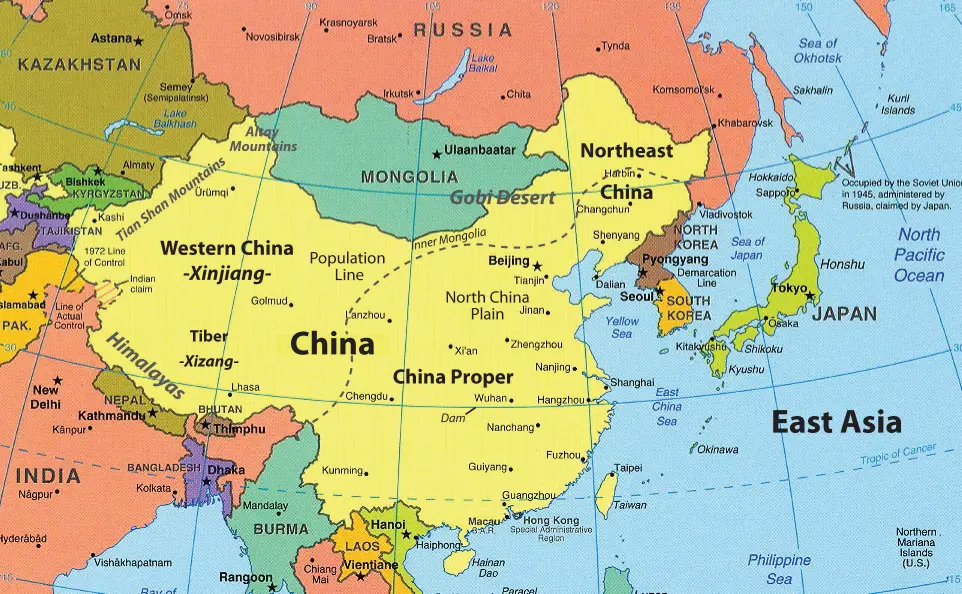In recent years, the Asian economy has grown significantly. Asia is on the verge of being on the threshold of the world, and the increases in the economy, military, businesses, and technology are things no one could have predicted 50 years ago. Japan, China, India, Thailand, and Korea are the key players in the Asian reign, and their economies contribute a large chunk to the Asian economy. Asia is also home to nations such as Bhutan, Bangladesh, Thailand, Korea, the Philippines, Indonesia, and others. The economic growth of most Asian nations is categorised as progressive, with room to grow and yet to reach their full potential.
China, which has seen its economy develop at astronomical rates since the turn of the century, remains Asia’s biggest economy, trailed by Japan, India, South Korea, and Indonesia. Collectively, these five represent a whopping 76.5% of Asia’s economy. Asia has significantly benefited from decades of growing financial and trade integration worldwide.
Asian Hierarchy and Resources
Apart from the Asian giants influencing commercial and trade ties, the Asian region remains rich in producing natural resources. Some of the most valuable minerals extracted in Asia are coal, petroleum, and natural gas, used as fuels. Roughly ‘three-fifths’ of the planet’s coal deposits are in Asia; India and China have the most noteworthy deposits, and North Korea, Indonesia, and Japan have fewer; nevertheless, they have significant economic reserves. China remains at the head of the table regarding the economy. In addition to China, Japan and India play a prominent role in making up Asia’s case; Japan is the third-largest world economy, and India is the world’s fifth-largest.
Iron ore reserves are available abundantly throughout Asia, but not all nations can access local supplies. Several smaller Southwest Asian countries, including South Korea, Taiwan, Sri Lanka, and others, have very modest iron ore. Throughout the years, many Asian nations have generated gold through riverbeds; Myanmar, Cambodia, and Indonesia generate small amounts of gold through their respective river streams. It is also noteworthy that many gold ore reserves still exist in Taiwan, the Philippines, and North and South Korea.
As a result of trade, investment, and improved knowledge exchange, financial integration in Asia increased enormously in the second half of the 20th century. The region of the continent that is most prosperous is East Asia.
Future of the Asian economy and factors associated with development
By 2030, Asia is projected to provide over 60% of worldwide growth. A high percentage (90%) of the 2.4 billion new middle-class people joining the global economy is predicted to be from the Asia-Pacific. Asia has added more deals with the United States and EU, and import-exporting trade increases the possibilities of future partnerships. The overwhelming expansion will originate due to Southeast Asia’s expanding economies, notably China and India. It will push enterprises, government agencies, and nongovernmental organisations to make fresh regional choices. They will steer Asia’s development equitably, addressing a broad spectrum of economic and social issues.
However, several harmful challenges loom large: the Russian war with Ukraine, a sharper-than-anticipated slowdown in global growth, stronger-than-anticipated tightening of fiscal policy in developed economies, a slowdown in China’s development, and unfavourable aftermath pandemic challenges could dampen the trajectory of the Asian economy. The pandemic delivered a massive blow to Asia’s economic statistics.
The lockdowns implemented in major Asian cities such as New Delhi, Tokyo, and Shanghai due to the zero-COVID policy force a re-evaluation of the hopes and aspirations of Asian giants. The regeneration process is slow, but to Asia’s credit, the COVID-19 crisis did not break the Asian spirit. Even though the impacts of the COVID-19 pandemic proved challenging, the Asian giants responded well to the situation, showcasing the principle of self-reliance and resilience. Asia’s ascend back to the near top is credited to the significant rise in exports, contrary to other European countries that heavily depended on external assistance and aid.
Challenges for Asia
Asian commodity prices are intensifying due to increased international costs for food and fuel brought on by the infiltration of Ukraine and its accompanying sanctions. Asia must focus on the establishment of a robust and adequately proficient workforce. Even after the critical and consistent structural changes due to globalisation, they must improve and upgrade education. A significant obstacle to developing the Asian economy remains that most Asian citizens continue to work in agricultural setups. Agriculture continues to be the largest profession in the Chinese and Indian economies, even if it contributes to a decreasing GDP.
Some other issues remain; finding regional and international cooperative solutions that lower trade policy uncertainty, eliminate harmful trade restrictions, and prevent the worst possible fragmentation scenarios is vitally necessary. Over the next few years, economic policies must focus on the increasing quantity supplied to combat high inflation in the region while addressing long-term environmental sustainability issues and continuing to invest in human resources.
The governments of Asia are the key to overcoming these challenges, and the collaborative efforts of the Global South will be imperative. Asia must focus on reasonable, productive, mutually beneficial relationships, advancing social and financial inclusion of all parties at the international and domestic levels. Implementing investor- and trade-friendly policies and encouraging social and economic participation could be vital to pushing the domestic working force forward and inviting foreign investors. If these are carried out precisely, the Asian economy will undeniably progress and emerge out of the shadow of the West.
